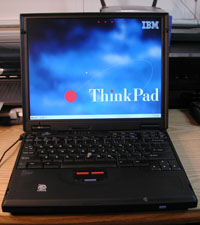In A Brief Lull
Not a lot of physical action on the project while I'm waiting on the RAM to arrive. The guys at Thinkpads.com tell me that in order for the TP-600 to recognize the 288MB the bios will have to be updated to the latest. After asking a few more questions, I knew how to determine the bios level on the machine, and it turned out to be Ver. 1.03, dated 4/2/98. I'd say that's a little out of date. I went to the IBM web site and downloaded the most current bios update for the TP-600 - Ver 1.22 dated 10/12/2001. Hopefully, the bios update will go on smoothly and the laptop will be ready for the RAM upgrade when it arrives.
I've been doing a lot of reading and research on desktop Linux distributions and have narrowed my focus down to four. There are literally 100's of Linux distributions to choose from, so I'm primarily been relying on published reviews. In my mind, I'm looking for: 1. Free, 2. small hardware footprint, 3. proven compatibility with the laptop and wireless, and 4. non-complex, ease of use, Newbie proof.
My search hasn't declared a clear winner, but the following four stand out as candidates worth trying: Ubuntu, Simply Mepis/MepisLite, Kanotix, and PClinuxOS. I've downloaded Ubuntu and Mepis and have the other two coming on CD.
I did discover something of interest, and probably the route I will follow. Most of the distributions are available on a "Live" CD which allows you to boot the linux OS off of the CD without disturbing your existing installed OS. This allows you to try it, verifying compatibility, look & feel, ... Etc. This way, I can fairly quickly try all four and determine which one works best for me and my application.
More on that as we go along. I'll likely be pretty quiet for a day or so until I get the laptop upgraded.


